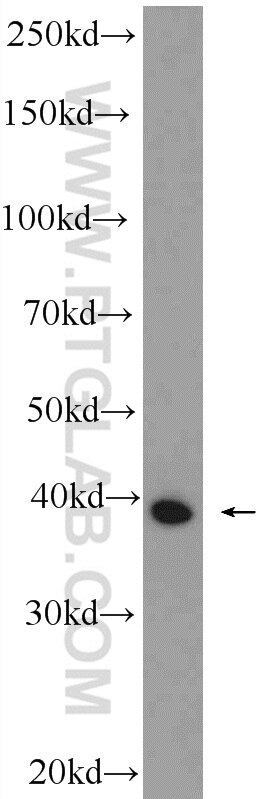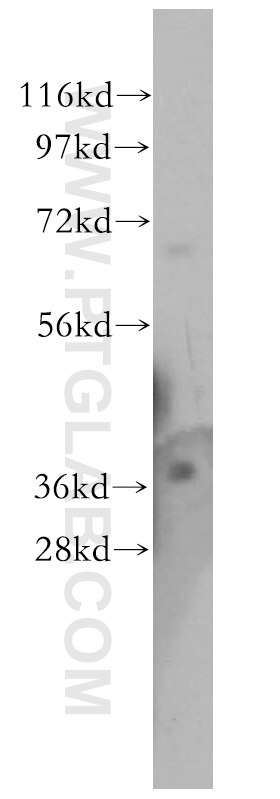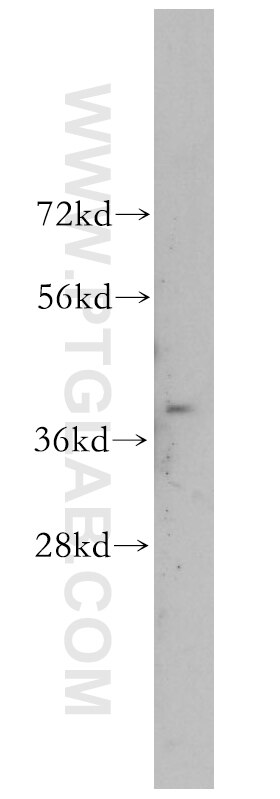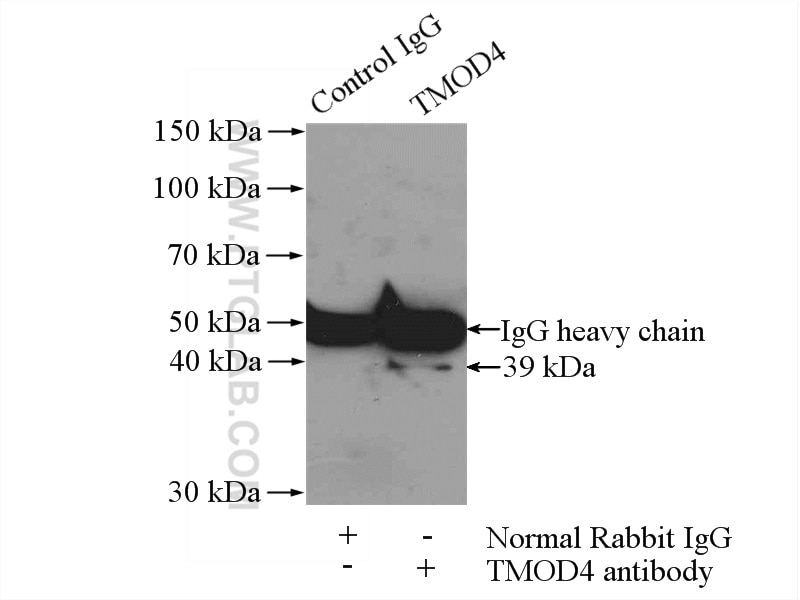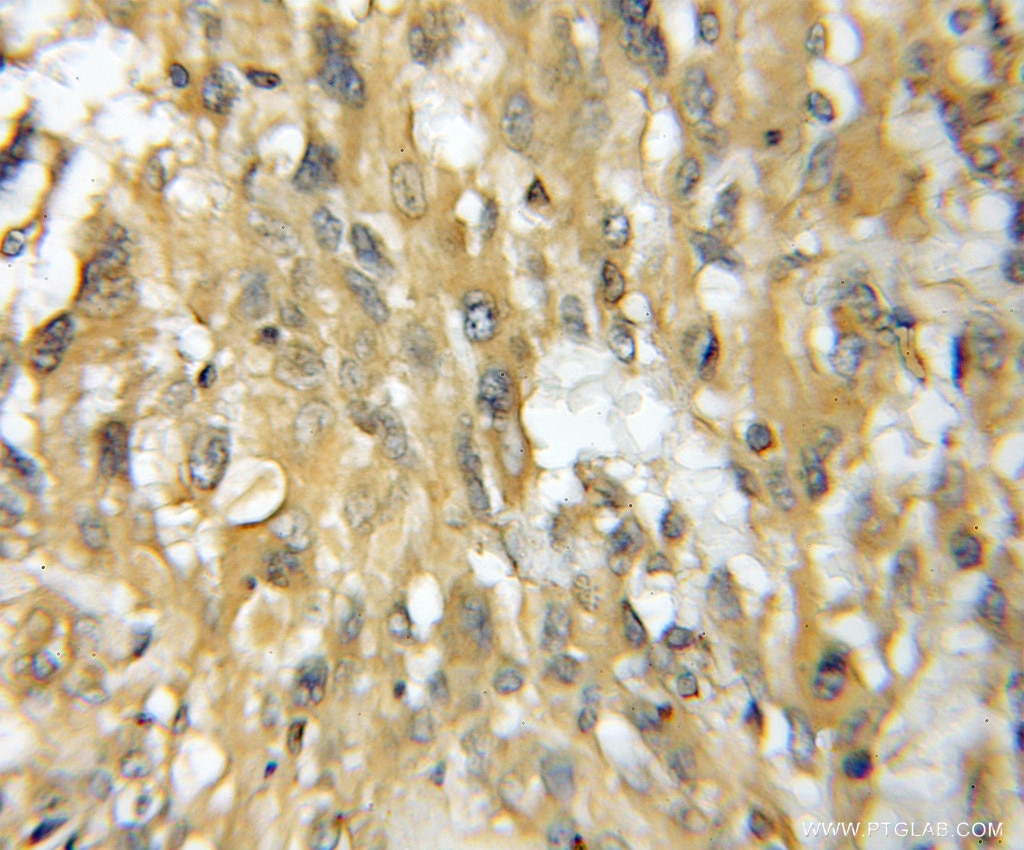TMOD4 Polyklonaler Antikörper
TMOD4 Polyklonal Antikörper für WB, IP, IHC, ELISA
Wirt / Isotyp
Kaninchen / IgG
Getestete Reaktivität
human, Maus, Ratte und mehr (2)
Anwendung
WB, IP, IF, IHC, ELISA
Konjugation
Unkonjugiert
Kat-Nr. : 11753-1-AP
Synonyme
Galerie der Validierungsdaten
Geprüfte Anwendungen
| Erfolgreiche Detektion in WB | Maus-Skelettmuskelgewebe, HeLa-Zellen, humanes Hirngewebe |
| Erfolgreiche IP | Maus-Skelettmuskelgewebe |
| Erfolgreiche Detektion in IHC | humanes Gliomgewebe Hinweis: Antigendemaskierung mit TE-Puffer pH 9,0 empfohlen. (*) Wahlweise kann die Antigendemaskierung auch mit Citratpuffer pH 6,0 erfolgen. |
Empfohlene Verdünnung
| Anwendung | Verdünnung |
|---|---|
| Western Blot (WB) | WB : 1:500-1:1000 |
| Immunpräzipitation (IP) | IP : 0.5-4.0 ug for 1.0-3.0 mg of total protein lysate |
| Immunhistochemie (IHC) | IHC : 1:20-1:200 |
| It is recommended that this reagent should be titrated in each testing system to obtain optimal results. | |
| Sample-dependent, check data in validation data gallery | |
Veröffentlichte Anwendungen
| WB | See 4 publications below |
| IHC | See 1 publications below |
| IF | See 3 publications below |
Produktinformation
11753-1-AP bindet in WB, IP, IF, IHC, ELISA TMOD4 und zeigt Reaktivität mit human, Maus, Ratten
| Getestete Reaktivität | human, Maus, Ratte |
| In Publikationen genannte Reaktivität | Maus, Ratte, Zebrafisch, Krallenfrosch (Xenopus) |
| Wirt / Isotyp | Kaninchen / IgG |
| Klonalität | Polyklonal |
| Typ | Antikörper |
| Immunogen | TMOD4 fusion protein Ag2349 |
| Vollständiger Name | tropomodulin 4 (muscle) |
| Berechnetes Molekulargewicht | 345 aa, 39 kDa |
| Beobachtetes Molekulargewicht | 39 kDa |
| GenBank-Zugangsnummer | BC017810 |
| Gene symbol | TMOD4 |
| Gene ID (NCBI) | 29765 |
| Konjugation | Unkonjugiert |
| Form | Liquid |
| Reinigungsmethode | Antigen-Affinitätsreinigung |
| Lagerungspuffer | PBS mit 0.02% Natriumazid und 50% Glycerin pH 7.3. |
| Lagerungsbedingungen | Bei -20°C lagern. Nach dem Versand ein Jahr lang stabil Aliquotieren ist bei -20oC Lagerung nicht notwendig. 20ul Größen enthalten 0,1% BSA. |
Hintergrundinformationen
TMOD4 is a member of tropomodulin (Tmod) family proteins which are capping proteins binding to the pointed end of actin filaments and preventing both elongation and depolymerization. Four mammalian Tmod genes have been identified to date. Tomd1 is expressed in terminally-differentiated post-mitotic cells, like heart, brain, lens, vasculature, and erythrocytes; Tmod2 expressed in neurons; Tmod3 expressed ubiquitously; Tmod4 expressed only in skeletal muscles. This antibody was raised against the full-length human TMOD4 and may cross-react with other Tmods.
Protokolle
| Produktspezifische Protokolle | |
|---|---|
| WB protocol for TMOD4 antibody 11753-1-AP | Protokoll herunterladen |
| IHC protocol for TMOD4 antibody 11753-1-AP | Protokoll herunterladen |
| IP protocol for TMOD4 antibody 11753-1-AP | Protokoll herunterladen |
| Standard-Protokolle | |
|---|---|
| Klicken Sie hier, um unsere Standardprotokolle anzuzeigen |
Publikationen
| Species | Application | Title |
|---|---|---|
Elife Downsizing the molecular spring of the giant protein titin reveals that skeletal muscle titin determines passive stiffness and drives longitudinal hypertrophy. | ||
J Cell Sci Leiomodin 3 and Tropomodulin 4 have overlapping functions during skeletal myofibrillogenesis. | ||
Dis Model Mech Loss of tropomodulin4 in the zebrafish mutant träge causes cytoplasmic rod formation and muscle weakness reminiscent of nemaline myopathy. | ||
J Proteome Res Proteomic and Phosphoproteomic Analysis of Right Ventricular Hypertrophy in the Pulmonary Hypertension Rat Model | ||
Front Physiol Titin isoform size is not correlated with thin filament length in rat skeletal muscle. |
